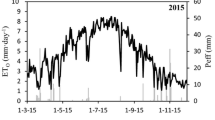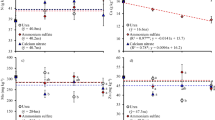Summary
Four cultivars of alfalfa (Medicago sativa L cv. Vangard, Cody, Zia, and Dawson) were grown under a gradient irrigation system on a Pullman clay loam soil (fine, mixed, thermic, Torrertic Paleustoll) at Bushland, Texas. Twelve harvests were taken during 1983, 1984 and 1985 over a wide range of irrigation levels. Alfalfa was harvested at 10% bloom and subsamples were oven dried and ashed. Irrigation water and rainfall were determined by catchment collections and soil moisture content was determined with a neutron soil moisture probe. Potential evaporation was determined by pan evaporation and by modified Penman, Priestley and Taylor, and Jensen and Haise prediction equations from climatic data. No varietal differences in the relationship of yield to water or water use efficiency occurred. Yield within each harvest correlated well with evapotranspiration (ET). The regression of yield with ET over all twelve harvests had a low coefficient of determination. Relative yield had a high correlation with relative ET when maximum ET was measured but the correlation was lower when maximum ET was calculated from a prediction equation or pan evaporation. The correlation increased when the maximum yield for each harvest was used rather than a constant value. Including a high temperature factor in the equation greatly improved the correlation between yield and ET but the correlation was not as high as when relative yield was correlated with relative measured ET. Water use efficiency was highest with the highest yields.
Similar content being viewed by others
References
Bauder JW, Bauer A, Ramirez JM, Cassel DK (1978) Alfalfa water use and production on dryland and irrigated sandy loam. Agron J 70:95
Brown RH, Pearce RB, Wolf DD, Blaser RE (1972) Energy accumulation and utilization. In: Hanson CH (ed) Alfalfa science and technology agronomy, vol 15. Am Soc Agron, Madison, WI, USA, p 143
Carter PR, Sheaffer CC (1983) Alfalfa response to soil water deficits I. Growth, forage quality, yield, water use, and water use efficiency. Crop Sci 23:669
Cohen OP, Strickling E (1968) Moisture use by selected forage crops. Agron J 60:587
Cole DF, Dobrenz AK, Massengale MA, Wright LN (1970) Water requirement and its association with growth components and protein content of alfalfa (Medicago sativa L.). Agron J 10:237
Daigger LA, Acthelm LS, Ashburn CL (1970) Consumptive use of water by alfalfa in Western Nebraska. Agron J 62:507
Davis JR, Fry AW, Jones LG (1963) Water supply and irrigation effects on alfalfa. Calif Agric 17:4
Donovan TJ, Meek BD (1983) Alfalfa responses to irrigation treatment and environment. Agron J 75:461
Doobrenbos J, Pruitt WO (1977) Guidelines for predicting crop-water requirements. FAO Irrigation and drainage paper 24. Food and Agriculture Organization of the United Nations, Rome, pp 1–114
Downey LA (1972) Water yield relations for non-forage crops. J Irrig Drain Div Am Soc Civ Eng 98:107
Hanks RJ, Keller J, Rasmussen VP, Wilson GD (1976) Line source sprinkler for continuous variable irrigation — crop production studies. Soil Sci Soc Am J 40:426
Hanks RJ, Stewart JI, Riley JP (1977) Four-state comparison of models used for irrigation management. Proc Irrig Drain Spec Conf Am Soc Civ Eng, pp 283
Hanson EG (1967) Influence of irrigation practices in alfalfa yield and consumptive use. NM State Univ Agric Exp Stn Bull 514, p 21
Jensen ME, Haise HA (1963) Estimating evapotranspiration from solar radiation. J brig Drain Div Am Soc Civ Eng 89:15
Johnson DE, Chaudhur UN, Kanemasu ET (1983) Statistical analysis of line-source sprinkler experiments and other non-randomized experiments using multivariate methods. Soil Sci Soc Am J 47:309
Lathwell DJ, Vittum MT (1962) Response of alfalfa to irrigation and fertility level. Agron J 54:195
Lucey RF, Tesar MB (1965) Frequency and rate of irrigation as factors in forage growth and water absorption. Agron J 57:519
Miller D, Melton B (1983) Description of alfalfa cultivars and germplasm sources. NM State Univ Agric Exp Stn Special Report 53
Peck NH, Vittum MT, Miller RD (1958) Evapotranspiration rates for alfalfa and vegetable crops in New York State. Agron J 50:109
Priestley CHB, Taylor RJ (1972) On the assessment of surface heat flux and evaporation using large-scale parameters. Mon Weather Rev 100:81
Retta A, Hanks RJ (1980) Corn and alfalfa production as influenced by limited irrigation. Irrig Sci 1:135
Sammis TW (1981) Yield of alfalfa and cotton as influenced by irrigation. Agron J 73:323
Stewart JI, Hagan RM (1969) Predicting effects of water shortage on crop yield. J Irrig Drain Div Am Soc Civ Eng 95:91
Author information
Authors and Affiliations
Additional information
Contribution Texas Agricultural Experiment Station. Paper No. 20929
Rights and permissions
About this article
Cite this article
Undersander, D.J. Alfalfa (Medicago sativa L.) growth response to water and temperature. Irrig Sci 8, 23–33 (1987). https://doi.org/10.1007/BF00256813
Received:
Issue Date:
DOI: https://doi.org/10.1007/BF00256813




